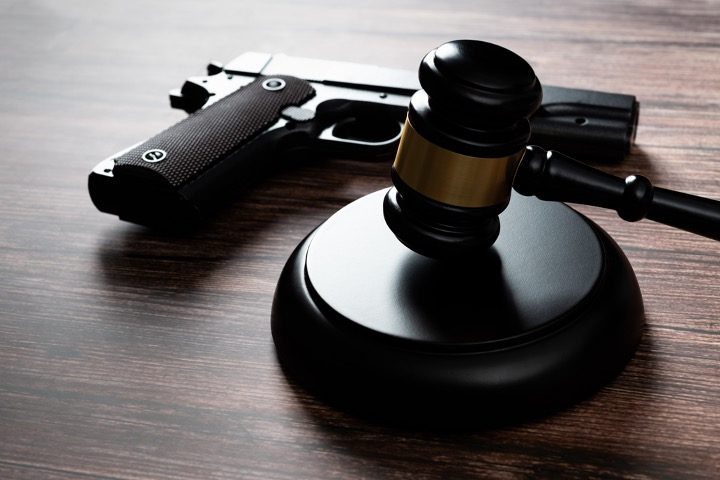
The Second Amendment Foundation (SAF) filed an amicus brief with the Supreme Court on Friday in the long-running war by Mexico against America’s gun-makers. An earlier brief, filed by 20 states’ attorneys general, focused on the protection provided by Congress when it passed the Protection of Lawful Commerce in Arms Act (PLCAA) in 2005.
The present brief focuses on the real intentions of Mexico working with anti-gun states and politicians: the destruction, through legal fees, of the industry altogether.
The original lawsuit, Estados Unidos Mexicanos v. Smith & Wesson Brands, Inc., filed in 2021, targeted key American gun makers (including Barrett Firearms Manufacturing; Beretta U.S.A.; Glock; Sturm, Ruger & Company; Century International Arms; and Colt’s Manufacturing Company). The lawsuit claimed that they “design, market, distribute and sell guns in ways they know routinely arm the drug cartels in Mexico. Defendants use reckless and corrupt gun dealers and dangerous and illegal sales practices that the cartels rely on to get their guns.”
When Adam Winkler, a law professor and gun-policy expert at the University of California, Los Angeles, learned of the lawsuit, he said that it was a “long shot,” adding:
Even if this lawsuit moves forward, it will be extremely difficult for Mexico to win because it will be hard to show that this distribution process or their distribution practices are a manifestation of negligence on the part of the gun makers.
The lower court appropriately tossed the lawsuit based on the PLCAA, specifically designed to protect America’s gun industry from such frivolous, and expensive, lawsuits.
On appeal to the notoriously liberal First Circuit in Boston (nine of the 11 current judges were appointed by Presidents Clinton, Obama, or Biden) that court reversed the lower court’s decision in January. It admitted that the PLCAA protected the industry from such frivolous lawsuits: “PLCAA’s limitations on the types of lawsuits that may be maintained in the United States apply to lawsuits initiated by foreign governments [like Mexico] for harm suffered outside the United States.”
And there it should have left the matter.
But, no: “We … reverse the district court’s holding that the PLCAA bars Mexico’s common law claims, and we remand [return the case to the lower court] for further proceedings.”
How? By claiming that the defendants “aided and abetted the knowingly unlawful downstream trafficking of their guns into Mexico.”
Montana’s state Attorney General Austin Knudsen led the coalition of state attorneys general filing the amicus brief in May 2023 urging the First Circuit to uphold the lower court’s decision:
Mexico advances a legal theory that is unsupported by fact or law. American gun manufacturers are not responsible for gun violence in Mexico.
Rather, policy choices by the Mexican government, policy failures in the United States, and independent criminal actions by third parties are alone responsible for gun violence in Mexico.
That brief, which the First Circuit ignored, made the following arguments in support of the lower court’s decision:
American gun manufacturers are not to blame for the increased gun violence in Mexico:
Only a minority of guns recovered at crime scenes in Mexico can be traced back to the United States.
Among the American guns recovered at crime scenes in Mexico, many were sold wholesale to the Mexican military and law enforcement and only ended up in cartel hands after soldiers or policemen deserted.
And the age of the few American retail guns that do end up in cartel hands suggests that these weapons were stolen, or sold on the black market, years after their legal sale in the United States and were not intentionally trafficked to Mexico through straw purchases.
Mexico’s war on cartels … caused Mexico’s homicide spike:
Felipe de Jesús Calderón Hinojosa … declared war on the cartels days after his inauguration in December 2006, and he deployed 30,000 Mexican troops across the country to end the drug trade.
The cartels responded with a counteroffensive against Mexican soldiers….
Calderón’s late-2006 declaration of war on the cartels reversed the declining homicide trend in Mexico.
From 2007 to 2008, homicides related to the drug war more than doubled. Mexico’s total homicide rate rose 57%. The increase continued for years, with drug war homicides increasing by another 41% between 2008 and 2009.
Mexico’s Complaint, and several amicus briefs, blame the sale of “assault weapons” in the United States for Mexico’s gun violence.
But gun violence in Mexico decreased in the three years after the U.S. assault-weapons ban expired and didn’t increase until “the [Mexican] government’s crackdown on the cartels.”
Few American retail guns are used in Mexican Homicides:
American-manufactured weapons constitute a small minority of guns recovered from crime scenes in Mexico…
And those guns are—on average—fifteen years old, which suggests that they arrive in Mexico through thefts, not straw purchases.
The American gun manufacturers sold firearms to the United States military services but, following policies of the past and present administrations, many of them found their way to Mexico:
These manufacturers sold guns to the United States military, not to the cartels or straw purchasers. That some of their guns made it into the hands of Mexican cartels is the result of American foreign policy failures, not decisions by American gun manufacturers.
Firearms found their way into the hands of the cartels thanks to actions by the Mexican government itself:
Another major (unintentional) supplier of American firearms to Mexican cartels is the Mexican government itself. For years, American gun manufacturers have supplied actual weapons of war—fully automatic, select-fire, and high-caliber rifles—to the Mexican army.
But when members of the Mexican army defect to join the cartels—usually to accept higher pay—they often bring their American-made service weapons with them.
From 2003 to 2009, around 150,000 Mexican troops defected to the cartels—taking their American-made rifles with them….
Mexico’s theory depends entirely on its claim that U.S. gun manufacturers intentionally supply the cartels with American guns.
But that’s not what the facts show. Few guns recovered at crimes [sic] scenes in Mexico are American made. Most of the guns that are American made, ended up in Mexico because of U.S. foreign policy failures, not because of American gun manufacturers. And, of the few retail guns that end up in Mexico, most of those come from thefts, not straw purchases.
The Second Amendment Foundation’s amicus brief, filed last week with the Supreme Court, went in a different direction. It pointed to the real intent of the original lawsuit (backed, not coincidentally, by 13 anti-gun states’ attorneys general and a “host” of “academics” and anti-gun groups): the economic destruction of the gun industry through endless and costly court battles.
It quoted various anti-gun lawyers who see the accomplishment of their anti-gun agenda through litigation. Said one: “Bankruptcy is a very useful negotiating tool and predictably the more suits that are filed, the more these gun companies are going to file for bankruptcy.” Said another: “The costs alone of defending these suits” would “eat up the gun companies.” Still another “boasted that he could force substantial increases in the gun industry’s insurance costs and the price of handguns, and perhaps even drive manufacturers out of the handgun business, even if he never won a single case.”
The recent bankruptcy of Remington and announcement by Colt’s that it would limit its supply of firearms and “effectively stop selling handguns to civilians” proves the success of the strategy.
This is how the anti-gun lobby intends to destroy America’s gun industry — not through legislation, but through litigation.



